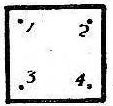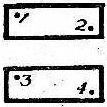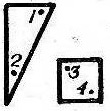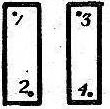The Guixie 庋擷 system (literally "picking from the shelf") is a character indexing system exclusively used by the Sinological Index Series of the Harvard-Yenching Institute (Hafo Yanjing xueshe 哈佛燕京學社) published by William Hung (Hong Ye 洪業, 1893-1980) in 1965.
Each character is assigned a combination of two numbers based on the general shape of the character and the shape of the (virtual) brush strokes of the four "corners" of the character. The general shape of the character can be derived from that of the representative lead characters 中, 國, 字, 庋, and 擷 (which gave the system its name, literally "Chinese characters picked from the shelf"). The number for each of the four corners can be memorized according to the written brush strokes in the characters 庋 and 擷 (the part 吉 is then replaced by 糸). The character 庋 is divided into five parts (丶, 一, 丿, 十, and 又), which are given the numbers 0 to 4, and the character 擷 into another five parts, numbered 6 to 9 (扌, 糸 [instead of 吉], 丆, 目, and 八).
| 0 | 丶 | all types of dots |
| 1 | 一 | all types of horizontal and right-bent structures |
| 2 | 丿 | all types of vertical and left-bent structures |
| 3 | 十 | all types of single-crossed structures |
| 4 | 又 | all types of diagonally crossed structures |
| 5 | 扌 | all types of double-crossed structures |
| 6 | 糸 | all types of tight tripartite structures and hooks of more than one stroke |
| 7 | 丆 | all types of single and multiple T-shaped structures in any direction |
| 8 | 目 | all types of corners and angles |
| 9 | 八 | all types of V-shaped structures in any direction |
It is important to note that the above described structures are not necessarily identical to real brush strokes as exercised in calligraphy and writing, but often only cover parts of brush strokes. The character 木, for instance, is separated into the structures 十 (for 丄) and 小, and NOT into 十, 丿 and 乀, as in normal writing.
Like in the Four Corners system, each character is assigned a four-digit number according to the form of the written structure in the four "corners" of the character, with the sequence left-top, right-top, left-bottom, right-bottom, yet there are exceptions for some compositional types of characters (see below).
This system is similar to the Four Corners system, but with different numbers and interpretations of what is a "hook" or an "edge". Compared to the Four Corners system, the guixie system tends to use as much structures as possible, whereas the Four Corners system often leaves the number 0 for the right-hand positions if part of a structure has already been used for left-hand positions. This rule is in the guixie system not applied to all cases, so that the character 口 is assigned the number 8888 in the guixie system (with the number 8 for each of the four corners), whereas it is 6000 in the Four Corners system (6 for the whole enclosure, and three times 0 for no remainders).
Another deviation from the Four Corners system is how characters are treated whose upper or lower parts do not show "corners" but only one protruding stroke. The Four Corners system in such cases dictates to use this protruding stroke as the left corner and to assign the number 0 to the particular right corner. The character 由 is therefore assigned the number 5060 (5 for a double-crossed vertical stroke 扌 and 6 for the enclosure 口) in the Four Corners system, but 5888 in the guixie system (5 for 扌and 8 for each of the three corners except the upper left). On the other side, the 0 rule is indeed sometimes made use of in the guixie system, as in the character 夕, which is 2820 in the guixie system (2 for the slant strokes丿, 8 for the corner フ, and 0 for the empty lower right corner), and analogous 2720 in the Four Corners system (7 for the hook フ).
Numbers are assigned to the most complex structure rather than to single shapes. This is particularly important for numbers 3 to 9 that stand for structures with (except 8) more than one part. The upper left structure of the character 中 is therefore 扌, a double-crossed vertical line, and not a single vertical line 丿 (丨), because the "corner" is always the uppermost structure in the character (the vertical stroke), and not a corner in its proper sense.
The general shapes of characters are divided into five compositional types:
| 1 | 中 |  |
stands for all types of characters appearing as a single block (like 口, 車, 帝, 表, 禹, 甚, 頁, 舟, 毋, 戍, 云, 勺, 尺 or 司). |
| 2 | 國 |  |
stands for all types of characters with an outer and an inner structure or characters with a large enclosing structure (like 園, 闢, 全 [王 being the inner part], 匡, 魁 [斗 being the inner part], or 幽, also 馬 [灬 being the inner part]). Separation into two parts is not allowed if only one stroke or two dots are left (as in 山, 日, 戌 or 舟: all 中 type) or two separated strokes (勿: is also 中 type). |
| 3 | 字 |  |
stands for all types of characters with an upper and a lower part (like 昌, 晶, 意, 莊, 符, 墮, or 羔, but also 矛 [マ being the upper part] and 豆 [the division being below the part 口; one would expect to classify both as of the 中 type], and also 商 and 用). It is not allowed that a brush stroke extends from the upper into the lower part (多: is 庋 type), and vice versa (吳: is 國 type). |
| 4 | 庋 |  |
stands for all types of characters with a top-left and a bottom-right part (like 厝, 皮, 廬, 羞, 病, 友, 石, 虎, 氏, 唇, 老, 君, or 欠, but also 昏, 炙, 多 [because no straight horizontal division line], as well as 乍, 無 [in the first volume of the series listed as an example for 字 type characters] and 年). Separation into two parts is not allowed if only one stroke is left (尺: is 中 type). |
| 5 | 擷 |  |
stands for all types of characters with a left and a right part (like 陳, 候, 刻, 彬, 孔, 競, or 胤, but also 州 and 川; one would expect these to be classified as of the 中 type). In characters that can be vertically divided into three parts, like 擷, the left part (扌) counts as left, and the middle and right parts (吉 and 頁) as the right part (頡). Similarly, 彬 consists of the parts 木 and 杉. Separation into two parts is not allowed if only one stroke is left (as in 心: is 中 type). |
The sequence of the numbers in the Four Corners system is always the same for all types of characters, except enclosures (like 園 or 闢), for which the third and fourth number are derived from the structure of the inner part of characters. The guixie system assigns a variational sequence for 國 type enclosures (upper left, lower right of the outer structure; upper left and lower right of the inner structure), characters of the type 庋 (upper RIGHT and lower LEFT for the upper structure 广; upper left and lower right of the lower structure 支), and characters with a left and a right part (upper left and lower right of the left part; upper left and lower right of the right part).
The indexing number of each character consists of the single number for the general shape and the four-digit number of the four corners separated by a slash, for instance, 4/3284 for 皮, or 5/9029 for 候. The first number has also the shape of Roman ciphers: I, II, III, IV, and V.
As the Four Corners system, the guixie system also makes use of an additional fifth number to avoid confusion in case that two or more characters have the same index number. This number is the amount of square structures (fangge 方格) within a character, including the cipher 0 if no square structure is there. Only square structures with right angles are counted (not the trapezoid in 夕 or the closed areas in 亞 or 凸), and only such in micro-structures (目 has three squares, not counting the outer frame; 回 has only one square, not two), and only such that are free from extensions from outside (as in 西 or the upper part of 曾).
The number of squares is limited to nine (畾 counts as nine squares, not 12). Quite difficult to assess is the number of squares in characters like 集 (3, inside the upper part 隹), 隹 (none, because the left and the right part of this 擷 type character are separated to create the index number), or 無 (3, above the lower horizontal stroke, and not the upper squares, also because the upper and the lower part of this 庋 type character are separated to create the index number).
There are therefore a lot of special regulations about the number of squares in particular structures.
The radical 肉, if written 月, includes 2 squares (even if the horizontal strokes are written as slant dots).